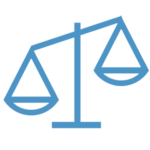What are the elements of a strong democracy?
The Center for High Impact Philanthropy has identified five elements of civil society that reinforce each other and act in concert toward creating a strong democracy. Philanthropic activities that support one or more of these elements serve to strengthen democracy.
CHIP’s “We the People: A Philanthropic Guide to Strengthening Democracy” creates a framework for anyone looking to strengthen the democratic system.
Empowered Citizens
The people are the principal actors in a democracy. Citizens are empowered when their rights are protected, they are informed, and fellow citizens and policymakers proactively engage them in the democratic process.
Fair Processes
As the mechanics of democracy, fair processes respect the principle of “one person, one vote” and hold policy-making institutions accountable through checks and balances.
Responsive Policy
As an output of democracy, responsive policy weighs all citizens’ interests and values equally, provides for the common good, and establishes institutions that empower individuals to protect their rights.
Information & Communication
These elements mediate the relationship between citizens, processes, and policy. Information and communication that are representative, accurate, and trusted ensure fair processes and enable citizens to hold policymakers accountable.
Social Cohesion
A shared sense of purpose and identity is implicit in the enduring phrase “we the people.” A democratic society’s members recognize each other’s right to a voice in the political process and are willing to collaborate for common ends.
Philanthropic efforts to strengthen democracy come from across the ideological and political spectrum, and take one of two distinct forms: support for institutions that advance the intrinsic value of and faith in democracy, and the use of democratic institutions as instruments to affect specific policy changes. Facilitating cross-party dialogue, endowing journalism schools, and supporting community projects at public parks and libraries are examples of the former. Advocating in support of specific legislation and voter mobilization around a specific cause are examples of the latter.
In identifying elements of a strong democracy, we incorporated the perspectives of foundations already active in the space, practitioners running democracy programs, and academics studying political and social behavior and institutions. We reviewed democratic theory, existing frameworks, foundation strategy documents, and grants to 150 nonprofit organizations in the democracy space.
Additionally, we analyzed eight widely used indices for measuring democratic health, which offer distinctive perspectives on the fundamental criteria of a democracy. (See Methodology) We also analyzed what large foundations are doing in this space. Several funders, such as the Hewlett Foundation’s Madison Initiative, the Charles Koch Institute, and Democracy Fund (a sponsor of this work), have published conceptual framings of democracy that inform their own grantmaking. Our contribution is to provide a framework broad enough to be applied by funders regardless of their current programmatic priorities.
Synthesizing all these various sources, and incorporating the feedback from a workshop of 20 funders, scholars, and practitioners, we arrived at the following five elements of a strong democracy. These elements characterize what an ideal democracy can look like. They reinforce each other and represent areas where philanthropy can help.
CHIP's Framework to Guide Philanthropic Action
ELEMENTS
What does success look like?
INDICATORS
What is the current state and how can we measure progress?
KEY DETERMINANTS
What factors drive success and improve the indicators?
WHAT DONORS FUND
What are real-world examples of what funders support?
Empowered Citizens

Measures of people’s engagement with and rights within formal and informal political institutions (e.g., voter turnout, popular knowledge of political information, and self-reported levels of autonomy)
Legal rights that are protected by courts, sources of information and education on public affairs, and civil society organizations that facilitate citizens’ engagement
• Civics education
• Community foundations
• Legal defense funds
• Training candidates for public office
Fair Processes

Measures of equality of participation and representation, measures of people’s faith in institutions and the rules that govern them
Accepted rules and norms that govern elections, legislatures, regulatory bodies, and courts; independence of election administration and judicial oversight, and transparency in government
• Voting rights litigation and advocacy
• Government watchdog organizations
• Electoral reform
Responsive Policy

Measures of the degree to which government produces effective policy that responds to the needs and voices of citizens (e.g., comparison of representatives’ voting record to constituents’ preferences)
Civil society organizations, procedures, and practices that allow interested citizens to influence policymaking (e.g., public comment periods for federal regulations, government transparency initiatives, and advocacy campaigns)
• Training to build capacity in government agencies
• Policy research
• Advocacy
• Oversight and monitoring activities
Information and Communication

Measures of the output of, access to, and trust in information about social and political life (e.g., number of news stories addressing local, critical information needs, polling on trust in media outlets, measures of online news engagement)
News reporting and research organizations, opportunities for public discourse, and access to technology. Historically, local news outlets provided both reporting on issues relevant to a community as well as opportunities for public discourse (e.g., hosting debates).
• Nonprofit journalism
• Think tanks
• Deliberative forums
• Civic tech (e.g., online voter registration)
Social Cohesion

Measures of diversity and inclusion, agreement on basic norms and values, and acceptance of outgroups (e.g., attitudes towards groups respondents don’t identify with)
Diverse and inclusive communities, public spaces, principled leadership, and civility in discourse
• Voluntary associations
• Anti-bigotry organizations
• Political bridge building
How We Designed This Framework
As a guide for social impact, the five elements for a strong democracy may seem broad or abstract, especially when compared to areas such as public health or education where donors might focus on more tangible outcomes like increasing lives saved or decreasing high school drop-out rates. The chart on the preceding page clarifies how these elements can inform funders’ decisions. Each element represents an aspect of democracy for funders to consider when evaluating philanthropic opportunities. The Indicators provide ways to measure the strength of each element. The Key Determinants identify factors that have been shown to positively influence those measures; they serve as potential points of philanthropic intervention. Finally, the Examples of What Donors Fund show existing, philanthropically-funded efforts.
When considering a philanthropic opportunity, funders can start by first understanding how it addresses one or more of these five elements. Nonprofit programs can link to multiple elements. For example, investigative journalism enhances information and communication, but can also enable responsive policy by highlighting issues that elected officials might address.
The Indicators help donors establish a baseline of the current state of affairs and provide insight as to where help may be needed. For example, a big difference between a representative’s voting record on an issue and the preferences of the majority of that person’s constituency may indicate an environment where policy is no longer responding to citizens needs and interests.
Where Indicators reveal a weakness, Key Determinants offer potential opportunities for philanthropy to intervene. For instance, if policy is not responsive to public demands, donors might examine whether legislative procedures are open to public input, or whether civil society organizations exist to aggregate and amplify the voices of citizens.
Philanthropic funders are already supporting multiple efforts to strengthen democracy. Large foundations (such as Arnold Ventures, Bloomberg Philanthropies, and Knight Foundation) are already funding efforts that reflect our framework’s elements. Take Back Our Republic supports organizing efforts across the country that empower citizens to act. Protect Democracy mounts legal challenges to ensure fair processes. Partnership for Public Service supports responsive policy by training newly appointed government agency leaders so they can fulfill their public mission. Nonprofit news organization ProPublica produces investigative journalism, information and communication in the public interest. America Indivisible fosters greater social cohesion by supporting interfaith conversations to fight anti-Muslim bigotry.
In the following sections, we examine how two broad approaches—increasing civic engagement and reinvigorating local media—can address multiple elements of a strong democracy. These two areas illustrate how funders can apply our framework to their philanthropic decisions. Read more >>

